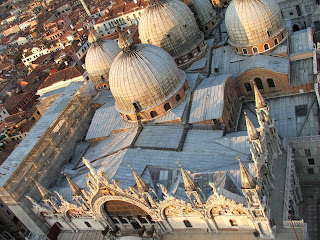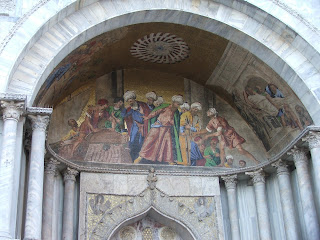While Venice as an island is small in size, it surely makes up for that by being large in stature. Venice, long the powerhouse nation, ruling the seas and the trade routes of the Mediterranean, with power extending all the way into the area now known as the Veneto. The majority of Venice's power was centered around those whole ruled over the Venetian empire from the St. Mark's area of the island.

St. Mark's Square in English, or San Marco in Italian, is the spot where the Doge's Palace sits, the famous Bridge of Sighs, the unique and distinguished St. Mark's Basilica, and the Campanile that stands tall looking down on all of it. Additionally, the famous winged lion sculpture atop the pedestal stands tall in the square looking down upon all those it rules over.


So naturally, this is the area where all of the tourists visiting the city eventually flock to fill the square - to tour the Basilica, to tour Doge's Palace, to take the elevator to the top of the Campanile, to sit at night and listen to the string quartet as it plays classical music on an almost deserted square, to see the gondolas on the Grand Canal bob up and down in the water, to people watch, to shop, to do all manner of different activities.


My first experience with St. Mark's Square came by vaporetto. Coming in on the vaporetto from Burano, after an 1.5 hour journey, we were let off at the San Zaccaria stop, right around the St. Mark's Square area. I already knew it was going to be a different experience than the one I had imagined when we were sailing through part of the Grand Canal and I saw huge yachts tied up along side the canal. Approaching sunset, the area was crowded with tourists, some milling about, other dragging around luggage looking lost, others just strolling with a cup of gelato in their hands. It was a blur of sights, and sounds.


As it was already approaching evening, we decided to just wander through the area and get our bearings. The first sight in the St. Mark's Square area that I saw was the Bridge of Sighs. This is the famous bridge that connects Doge's Palace to the prison, and it's often said that the slight opening in this concrete bridge provided convicted criminals of their very last glimpse of Venice. I was, however, disappointed with the Bridge. As there are restoration projects ongoing in the general vicinity, the canal over which the bridge lies was completely covered in advertising for a clothing company. In fact, everything was covered except for the bridge itself. But the design and the colors were such that the Bridge kind of just disappeared into the background.


As I got closer to St. Mark's Square, the crowd began to grow more thick, and dodging other tourists almost became a game. When I reached the bell tower, or the Campanile, I discovered that it was still open at this hour. I had planned all along to go to the top of the Campanile for views over Venice. The Campanile towers over all of Venice, and from high atop this island city, you can get a beautiful view, especially around sunset. The elevator ride to the top was short. However, right when I got on the elevator, the clock struck 8:00 pm, and the bells in the tower began to ring. It was quite the experience to ride in the elevator and hear the bells high above you ring with the sound reverberating inside this elevator car. When the elevator reached the top and the doors opened, the sound of the ringing bell was incredibly loud. It was a sight to see this massive iron bell swinging back and forth notifying all within hearing distance that the top of another hour had arrived. The view from the top of the Campanile is amazing. It was a clear and beautiful day and I could see out in the Venetian Lagoon and all throughout the island. It was quite the sight to see all these red tiled roofs packed in closely. Off in the far distance I could make out the 4 cruise ships in port on this day. And when you looked down below, it was a different perspective from which to view the Doge's Palace, St. Mark's Basilica and St. Mark's Square. This view, from the top of the bell tower, just before sunset, is one of those views that just kind of takes your breath away. I know that when I think of Venice, this is one of the views I'll always think of.




Once I was back down on the ground, I took some time to just soak it all in. Marvel at the sights and stand in wonder at this mythical city.




The next morning, I made my way back to St. Mark's Square. It was just past 8:00 am and the square was virtually deserted. This is another view of St. Mark's Square, one that most visitors never see. This big open square, merchants coming out to clean up their storefronts and set up for the coming day, the bells of the Campanile ringing in the morning, the Basilica standing there shrouded in shadows, and the imposing Doge's Palace right next door. It was so peaceful and serene to walk around near the canal's edge and not constantly be bumping into other tourists and just being able to listen to the water of the Grand Canal lap up against the banks.


I had pre-reserved online entrance tickets to St. Mark's Basilica. That saved us a lot of time and the aggravation of waiting in line. The Basilica opened to the public at 9:45 am, by 8:30 am, there was already a line forming outside of the Basilica. By 9:30 am, the line reached out almost to the Grand Canal. I personally found the exterior of the Basilica to be much more interesting than the interior. The mosaics work on the Basilica is amazing. All the intricate detail that is needed to depict scenes from the life of St. Mark. However, to me, the inside of the Basilica seemed dark and uninviting. And while it is historical, it seemed rather bland and uninteresting.


By the time we exited St. Mark's the square was really beginning to fill up with tourists, the sun was starting to shine high above, and it was time to make our way back to the ship for sail away.






























